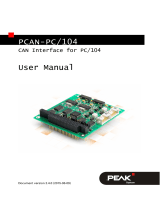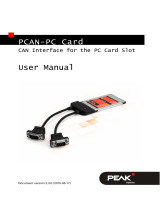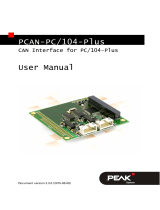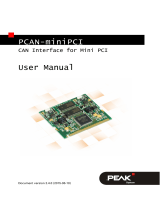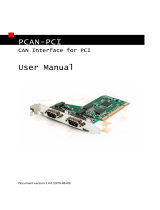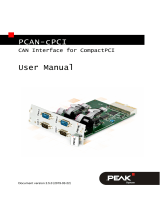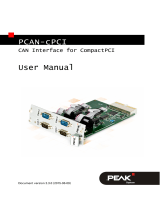Page is loading ...

PCAN-ISA
CAN Interface for ISA
User Manual

PCAN-ISA – User Manual
2
Products taken into account
Product Name Model Item Number
PCAN-ISA Single Channel One CAN channel IPEH-002074
PCAN-ISA Dual Channel Two CAN channels IPEH-002075
PCAN-ISA Single Channel
opto-decoupled
One CAN channel, galvanic
isolation for CAN connection
IPEH-002076
PCAN-ISA Dual Channel
opto-decoupled
Two CAN channels, galvanic
isolation for CAN connections
IPEH-002077
The cover picture shows the product PCAN-ISA Dual Channel opto-decoupled. Other
product versions have an identical form factor but vary in equipment.
Product names mentioned in this manual may be the trademarks or registered
trademarks of their
respective companies. They are not explicitly marked by “™” and
“®”.
© 2012 PEAK-System Technik GmbH
PEAK-System Technik GmbH
Otto-Roehm-Strasse 69
D-64293 Darmstadt
Germany
Phone: +49 (0)6151-8173-20
Fax: +49 (0)6151-8173-29
www.peak-system.com
info@peak-system.com
Issued
2012-02-15

PCAN-ISA – User Manual
3
Contents
1 Introduction 4
1.1 Properties at a Glance 4
1.2 System Requirements 5
1.3 Scope of Supply 6
2 Hardware Installation 7
2.1 Configuring the PCAN-ISA Card 7
2.2 Installation into the Computer 10
2.3 Modifying the Computer's BIOS Settings 11
2.3.1 Indicating Used Interrupts 11
2.3.2 Deactivating the APIC Mode 12
2.4 Connecting a CAN Bus 13
2.5 5-Volt Supply at the CAN Connector 14
3 Software Setup 16
4 Software 17
4.1 PCAN-View for Windows 17
4.2 Linking Own Programs with PCAN-Light 19
5 Frequently Asked Questions (FAQ) 21
6 Technical Specifications 22
Appendix A CE Certificate 24
Appendix B Quick Reference 25

PCAN-ISA – User Manual
4
1 Introduction
Tip: At the end of this manual (Appendix B) you can find a
Quick Reference with brief information about the installation
and operation of the PCAN-ISA card.
With the PCAN-ISA add-on card for the ISA bus in the computer you
can connect one or with the Dual Channel version even two CAN
busses. Thus the computer becomes part of a High-speed CAN
network (HS-CAN). The applications running on the computer are
the CAN nodes.
The registers of a CAN controller can be directly addressed via the
I/O addresses of the computer.
With the opto-decoupled versions of the PCAN-ISA card an isolation
of up to 500 V between the computer and the CAN parts of the card
is achieved by use of a DC/DC converter and an optocoupler.
Note: This manual refers to different versions of the PCAN-ISA
card (see also
Products taken into account
on page 2).
Differences at use and at the technical specifications are
mentioned accordingly in this manual.
1.1 Properties at a Glance
Extension card for ISA slot (16 bit) in the computer
Support of interrupts IRQ3 – IRQ5, IRQ7, IRQ10 – IRQ12, IRQ15
(manual setup with jumpers)
Shared interrupt possible for use with several cards or the Dual
Channel version in a computer

PCAN-ISA – User Manual
5
Connection of a High-speed CAN bus (two with the Dual
Channel version), CAN specifications 2.0A and 2.0B
Equipped with one or two CAN controllers SJA100T by
Philips/NXP (independently configurable)
CAN connection 9-pin D-Sub male, pin assignment according to
CiA recommendation DS 102
CAN transfer rate up to 1 MBit/s
Galvanic isolation up to 500 V for the CAN interface (only opto-
decoupled versions)
Support for operating systems Windows (starting with 2000) and
Linux
Note: This manual describes the use of the PCAN-ISA card with
Windows. You can find device drivers for Linux and the
corresponding information on PEAK-System's website under
www.peak-system.com/linux.
1.2 System Requirements
The following prerequisites must be given, so that the PCAN-ISA
card can be used properly:
An empty ISA slot (16 bit) in the computer
Operating system Windows (Vista, XP SP2, 2000 SP4) or Linux

PCAN-ISA – User Manual
6
1.3 Scope of Supply
The scope of supply normally consists of the following parts:
PCAN-ISA card
Slot bracket with one or two CAN D-Sub connectors including
cables to the PCAN-ISA card
CD-ROM with software (drivers, utilities), programming exam-
ples, and documentation

PCAN-ISA – User Manual
7
2 Hardware Installation
2.1 Configuring the PCAN-ISA Card
Before you install the PCAN-ISA card into the computer you may
need to configure it. For each CAN channel an interrupt (IRQ) and an
I/O address range is set for operation in the computer.
At delivery the PCAN-ISA card has the following default settings:
CAN Channel IRQ I/O Address Range Remark
1 10 300h – 31Fh
2 5 320h – 33Fh Only on the Dual Channel version
Tip: If the given resources are not firmly occupied by other
devices, you can skip the configuration and directly continue
with the following manual section 2.2.
For a configuration differing from the default settings you need to
set jumpers on the PCAN-ISA PCB according to the following
explanations.
Position of the Jumper Fields on the PCAN-ISA Card
The single-channel version of the PCAN-ISA card has two jumper
fields, one for the setting of the I/O address range and one for the
setting of the interrupt (Figure 1). Accordingly the Dual Channel
ver
sion has the doubled layout (Figure 2).

PCAN-ISA – User Manual
8
Figure 1: PCAN-ISA Single Channel – Position of the jumper fields for setting
the I/O address range (JP1, left marker)
and the interrupt (JP3, right marker)
Figure 2: PCAN-ISA Dual Channel – Position of the jumper fields for setting
the I/O address ranges (JP1, JP2, left marker)
and the interrupts (JP3, JP4, right marker)
I/O Address Range
Each CAN channel must be assigned to an unique I/O address range
in the computer. An address space from 200h up to 39Fh (h =
hexadecimal) is available. The PCAN-ISA card uses 32 addresses
beginning from the configured base address. The configuration is
done on jumper field JP1 for CAN channel 1 and jumper field JP2
for CAN channel 2 (latter only with the Dual Channel version).

PCAN-ISA – User Manual
9
The following table shows the possible settings. The X stands for a
set jumper. The default settings at delivery for CAN channels 1 and
2 are highlighted.
Jumper field JP1/JP2
A B C D E
I/O address range
X 200h – 21Fh
X X 220h – 23Fh
X X 240h – 25Fh
X X X 260h – 27Fh
X X 280h – 29Fh
X X X 2A0h – 2BFh
X X X 2C0h – 2DFh
X X X X 2E0h – 2FFh
X X 300h – 31Fh
X X X 320h – 33Fh
X X X 340h – 35Fh
X X X X 360h – 37Fh
X X X 380h – 39Fh
Interrupt
An interrupt (IRQ) must be assigned to each CAN channel. The
PCAN-ISA card supports the interrupts 3, 4, 5, 7, 10, 11, 12, and 15.
The default setting at delivery for CAN channel 1 is interrupt 10, for
CAN channel 2 interrupt 5.
It is possible to share the same interrupt between two existing CAN
channels. Therefore you can configure the same interrupt, when
using two PCAN-ISA cards in the same computer.
Tip: We suggest to configure different interrupts as long as
resources allow it and use interrupt sharing only, if this is not
the case.

PCAN-ISA – User Manual
10
2.2 Installation into the Computer
Do the following to install the PCAN-ISA card into the computer:
1. Make sure that the computer is turned off (power switch at
the computer's supply unit).
2. Open the casing and plug the PCAN-ISA card into an empty
slot on the computer's motherboard. For details please refer
to the documentation of the computer.
3. In the computer replace a slot bracket with the supplied slot
bracket containing the D-Sub connector(s) for the CAN bus,
if applicable.
4. For each CAN channel connect the flat cable to the
corresponding connector on the PCAN-ISA card.
You can look up the pin assignment of the 10-pin CAN
connectors on the card in section 0 on page 11.
Figure 3: Connectors for the cable(s) to the slot bracket (here: PCAN-ISA Dual
Channel, the single-channel version only has the left connector Ch1)
5. Close the computer's casing.
Note: Before switching on the computer, please follow the
procedure for modifying the computer's BIOS settings
described in the following section.

PCAN-ISA – User Manual
11
2.3 Modifying the Computer's BIOS Settings
To ensure a flawless operation of the PCAN-PC/104 card it is neces-
sary that you adjust settings in the BIOS setup of the computer:
Indicate used interrupts
Deactivate the APIC mode
Note: Due to a diversity of existing BIOS setup versions for
computers we cannot give detailed instructions here. Instead
we indicate common setting names.
In order to know how to start the computer's BIOS setup please
consult the corresponding documentation. Usually you can enter
the BIOS setup by pressing the Del or F2 key shortly after switching
on the computer.
2.3.1 Indicating Used Interrupts
By indicatin
g the interrupts that are set on the PCAN-PC/104 card,
you avoid that the corresponding resources are automatically
assigned to other devices and that this results in conflicts.
In the BIOS setup itself you can often find the settings for the
interrupts under a menu item containing the text “PnP”. For the
interrupt(s) used by PCAN-PC/104 change the setting to “Reserved”
or “Legacy ISA”.

PCAN-ISA – User Manual
12
2.3.2 Deactivating the APIC Mode
Note: Do not mix up APIC with ACPI.
The APIC mode is a certain type of interrupt management in a
computer.
If the APIC mode is active in your computer, you must deactivate it
so that the PCAN-PC/104 card can work properly with interrupts.
Do the following to determine in Windows if the APIC mode is
active:
1. Open the Windows Device Manager.
2. Select the menu entry View > Resources by type.
3. Open the branch of Interrupt request (IRQ).
If entries with interrupt numbers greater than 15 are listed,
the APIC mode is active and you must deactivate it.
Do the following to deactivate the APIC mode:
Important note: When you deactivate the APIC mode in the
BIOS setup, it may happen that you must reinstall Windows
afterwards, because it cannot start anymore due to the low-
level setting.
1. Restart the computer and switch to the BIOS setup.
2. Search for the APIC setting and deactivate it.
3. Save the changes in the BIOS and quit the BIOS setup.
4. If Windows doesn't start properly, reinstall it or perform a
repair installation.

PCAN-ISA – User Manual
13
2.4 Connecting a CAN Bus
A High-speed CAN bus (ISO 11898-2) is connected to one of the
9-pin D-Sub ports on the slot bracket. The pin assignment
corresponds to the CiA recommendation DS 102-1.
Figure 4: Pin assignment HS-CAN
(view onto connector of the slot bracket)
The pin assignment between the D-Sub port and the 10-pin
connector on the PCAN-ISA card is as follows:
Figure 5: Numbering at the 10-pin connector
Pin Assignment Assignment D-Sub
1 +5 V (optional) 1
2 GND 6
3 CAN_L 2
4 CAN_H 7
5 GND 3
6 not connected 8
7 not connected 4
8 +5 V (optional) 9
9 not connected 5
10 not connected

PCAN-ISA – User Manual
14
2.5 5-Volt Supply at the CAN Connector
You can route a 5-Volt supply to pin 1 and/or pin 9 of the CAN
connector (independently for each CAN connector on the Dual
Channel version) by setting solder bridges on the PCAN-ISA card.
Thus devices with low power consumption (external transceivers or
optocouplers, for example) can be directly supplied via the CAN
connector.
When using this option the 5-Volt supply is connected to the power
supply of the computer and is not fused separately. The opto-
decoupled versions of the card contain an interconnected DC/DC
converter. Therefore the current output is limited to about 50 mA.
Attention! At this procedure special care is indispensable, since
there is a short circuit danger. The PCAN-ISA card could be des-
troyed and/or the power supply or electronics of the computer
or other components connected could be damaged.
Attention! Risk of short circuit! If the option described in this
section is activated, you may only connect or disconnect CAN
cables or peripheral systems (e.g. external transceivers or opto-
couplers) to or from the PCAN-ISA card while the computer is
de-energized.
Important note: PEAK-System Technik GmbH does not give
guarantee on damages which have resulted from application of
the option described in this section.
Set the solder bridge(s) on the card according to the desired set-
tings. Figure 6 shows the positions on the card; the table below
con
tains the possible settings.

PCAN-ISA – User Manual
15
Figure 6: Position of the solder bridge fields for the 5-Volt supply
5-Volt supply →
None Pin 1 Pin 9 Pin 1 + Pin 9
JP5 (CAN channel 1) /
JP6 (CAN channel 2)

PCAN-ISA – User Manual
16
3 Software Setup
Under Windows a driver is needed that can access the PCAN-ISA
card and that provides the interface for Windows applications.
Beside the mentioned device driver the CAN monitor PCAN-View
for Windows can also set up.
Do the following to setup the driver and, if applicable, additional
software:
1. Please make sure that you are logged in as user with admi-
nistrator privileges (not needed for normal use of the PCAN-
ISA card later on).
2. Insert the supplied CD-ROM into a drive of the computer.
Usually a navigation program appears a few moments later.
If not, start the file Intro.exe from the root directory of the
CD-ROM.
3. Navigate through the menus to the driver installation for the
PCAN-ISA card (English > Drivers > PCAN-ISA). Click on
Install now afterwards. The setup program for the driver is
executed. Under Windows Vista you may need to confirm
the note about the execution with elevated rights.
4. Follow the instructions of the setup program.

PCAN-ISA – User Manual
17
4 Software
This chapter deals with the provided software and the software
interface to the PCAN-ISA card.
4.1 PCAN-View for Windows
PCAN-View for Windows is a simple CAN monitor for viewing and
transmitting CAN messages.
Installation
You can install the application optionally during the driver setup
procedure (see also chapter 3
Software Setup
on page 16).
Program Start
In the Start menu of the Windows desktop you can find the entry
“PCAN Hardware”. From there you can execute the program PCAN-
View.
A dialog for the selection of the CAN hardware as well as the setting
of the CAN parameters appears after the program start.

PCAN-ISA – User Manual
18
Figure 7: Selection of the CAN specific parameters
If no entry is in the list “Available CAN hardware” (for example at
the first program start), you need to add one:
1. Press the button Add. The dialog box “Add CAN hardware”
appears.
2. Select the connected hardware and the operating mode
from the list “Type of CAN hardware”.

PCAN-ISA – User Manual
19
Figure 8: Selection of hardware resources
3. Enter the I/O base address and the interrupt set on the
PCAN-ISA card (see section 2.1
Configuring the PCAN-ISA
Card
on page 7).
4. Confirm your input with OK.
In the dialog box “Connect to CAN hardware” you may make
further settings (baud rate and CAN message filter) for the created
hardware entry.
If you need further help after the program start, use the online help
provided with the program (F1 key).
4.2 Linking Own Programs with PCAN-Light
On the supplied CD-ROM you can find files that are provided for
software development. You can access them with the navigation
program (button Programming). The files exclusively serve the
linking of own programs to hardware by PEAK-System with the help
of the installed device driver under Windows.

PCAN-ISA – User Manual
20
Further more the CD-ROM contains header files and examples for
creating own applications in conjunction with the PCAN-Light
drivers. Please read the detailed documentation of the interface
(API) in each header file.
Tip: You can find further information in the file
PCANLight_enu.chm (Windows Help file) on the CD-ROM.
Notes about the License
Device drivers, the interface DLL, and further files needed for linking
are property of the PEAK-System Technik GmbH (PEAK-System)
and may be used only in connection with a hardware component
purchased from PEAK-System or one of its partners. If a CAN
hardware component of third party suppliers should be compatible
to one of PEAK-System, then you are not allowed to use or to pass
on the driver software of PEAK-System.
PEAK-System assumes no liability and no support for the PCAN-
Light driver software and the necessary interface files. If third party
suppliers develop software based on the PCAN-Light driver and
problems occur during use of this software, please, consult the
software provider. To obtain development support, you need to
own a PCAN-Developer or PCAN-Evaluation version.
/

